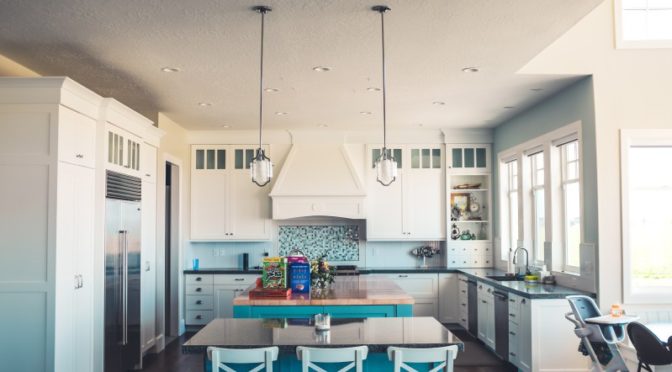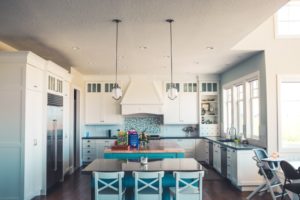
A kitchen floor needs to stand up to a lot. Aside from regular foot traffic (the kitchen is one of the most heavily trafficked rooms in any home), it’s also got to deal with spills, splashes, stains, heat, and who knows what else on a regular basis. As a result, it’s no surprise that one of the most frequent requests we get is for information on durable kitchen flooring. We’ve covered kitchen flooring options before (e.g., with a focus on water resistance or with affordability as a priority), but today we’ll cover it again with a focus on longevity, ease of maintenance, and aesthetics.
For looks and durability, look no further than ceramics and porcelain tiles

If you’re most interested in durability paired with attractiveness, it’s hard to beat ceramic and porcelain floor tiles for kitchens. They’re made to be waterproof, hard, easy to clean, and unstainable. They won’t be damaged by heat and they won’t break. Unless you drive heavy machinery over them, they’re likely to last for the life of your home, barely changing as the years go by. You can also buy ceramic and porcelain tiles in a range of colors, patterns, shapes, and sizes, meaning your design options are essentially limitless.
Concrete is environmentally friendly and about as tough as it gets
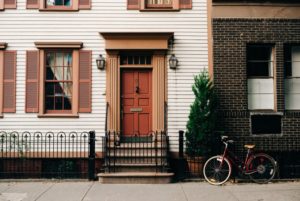
If you don’t want to deal with laying down tile, which can be a beast of a job, consider concrete. If your kitchen is on the ground floor, it’s hard to get cheaper than concrete, because a slab of it will generally already be installed beneath whatever existing floor you have in your home. You can then polish, stain, or otherwise modify this floor to make it work well for your kitchen. If you don’t have the luxury of a pre-poured slab, it’s easy to have new concrete poured over a range of subfloors. Concrete may be hard–some might say too hard–but there’s no question about its longevity.
Stay away from hardwood flooring unless it’s treated (and you’re okay with a weathered look)
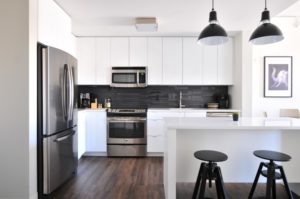
If your top priority is to have a floor that looks good, even if it takes more maintenance to keep in good shape, it’s hard to top kitchen hardwood flooring. But while it will undoubtedly look good upon installation, you’re going to need to pay much more attention to avoiding water and staining. That said, if you have it installed with a urethane finish (or if you apply a finish on your own), you can make hardwood floors work in most kitchens as long as you pay attention to stains and moisture.
No matter how careful you are with hardwood flooring, if you use it in a kitchen, it’s naturally going to degrade to some degree as the years go by; stains, spills, and splatters will add up with the natural rhythms of cooking. However, the appearance of a well-used and well-loved hardwood floor can be a big draw, especially if you’ve put the years on the floor yourself. There’s also always the potential for a floor refinish if you want to restore its original luster.
When all else fails, you’ll get the most bang for your buck with vinyl
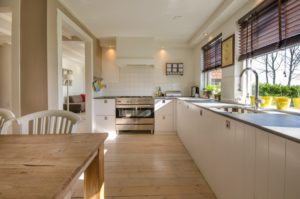
Finally, although it’s not the most luxurious choice, vinyl remains the most sought-after kitchen flooring option for four reasons: it’s incredibly durable, it’s waterproof, it needs no maintenance whatsoever, and it’s highly affordable. Vinyl is essentially a sheet of plastic laid down on your subfloor, and it’s about as hardy as a Tupperware container. The only things you need to do to keep it clean are to sweep or vacuum it, although you can also wet mop it whenever you want, since it’s completely waterproof. The biggest downsides to vinyl have to do with its appearance; while it can last for decades before developing rips and tears, much like any plastic dish, it’ll generally start fading after around a decade of daily use in your home, which includes in your kitchen.
Here’s what you want in a vacuum for your kitchen floor (and the rest of your home)
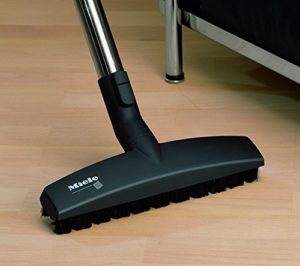
Regardless of which floor you eventually settle on for your kitchen, if you want it to last, you’re going to want to keep it clean. Not only will this improve aesthetics, it’ll also potentially add years to its longevity by keeping you aware of small problems like cracks before they turn into big ones. If you’re like most homeowners, you’ll choose a bare floor for your kitchen, which means you’ll want a Parquet head for maximum efficiency. We like Parquet heads because they clean dirt quickly instead of simply pushing it around the way other brush heads often do on bare floors.
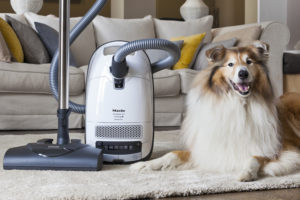
However, because you’ll almost certainly have carpets elsewhere in your home, you’ll also want an electric brush head, as you’ll need one to effectively brush dirt out of carpets of varying piles and styles. To get the job done, we recommend the Miele Complete C3 Cat & Dog (reviewed here and here) or Miele Compact C2 Electro+ (reviewed here and here); both are designed to clean just about any floor you could possibly own while offering buy-it-for-life reliability.
![]() You can buy the Miele Complete C3 Cat & Dog here on Amazon or buy the Miele Compact C2 Electro+ here.
You can buy the Miele Complete C3 Cat & Dog here on Amazon or buy the Miele Compact C2 Electro+ here.
![]() Canadians can buy the Miele C3 Cat & Dog here or buy the Compact Electro+ here.
Canadians can buy the Miele C3 Cat & Dog here or buy the Compact Electro+ here.
 If you find our research on PMC helpful, you can follow our efforts to keep maniacally reviewing home cleaning tools by shopping through our links above. We promise to keep fighting the good fight against every horror children, animals, and grown, yet messy humans can inflict upon a clean home.
If you find our research on PMC helpful, you can follow our efforts to keep maniacally reviewing home cleaning tools by shopping through our links above. We promise to keep fighting the good fight against every horror children, animals, and grown, yet messy humans can inflict upon a clean home.

